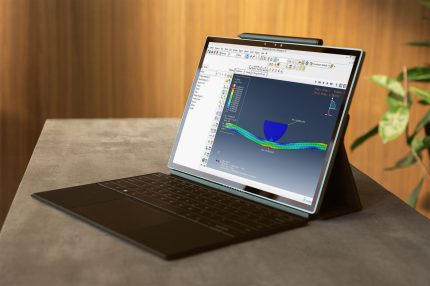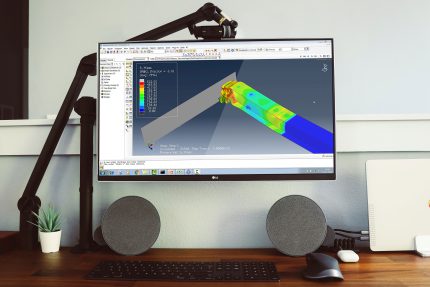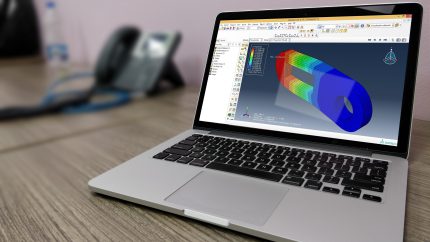ADVANCED ABAQUS SUBROUTINE COURSE
Start from Tuesday 6/25/2023 12:30 PM GMT+3:30
First Session for free! Abaqus subroutine course
Detailed Instruction Video
Uniqe, Exclusive & Practical
Bridging Theory & Simulation
Abaqus Subroutine Course Overview
Master complex engineering challenges in Abaqus with this comprehensive course on advanced subroutines. Extend the software’s capabilities and create highly customized simulations.
Dive deep into UMAT, VUMAT, USDFLD, VUSDFLD, UHARD, VUHARD, UMATHT and UHYPER to craft unique material models, define hardening behavior, model thermal effects, and internal heat generation with HETVAL.
Go beyond built-in options with DLOAD, VDLOAD and DFLUX, VDFLUX for intricate loading scenarios and heat flux variations. Achieve time-dependent loads and boundary conditions using UAMP, VUAMP, DISP, and VDISP.
Unlock advanced control with UMESHMOTION for mesh motion and UEL, VUEL for intricate element behavior. Simulate complex friction with VFRICTION, VFRIC, and manage user-defined outputs and thermal strains with UVARM, VUVARM, UEXPAN, and VUEXPAN.
This course is ideal for experienced Abaqus users seeking to push simulation boundaries and solve real-world engineering problems beyond traditional methods.
This course appears to be a comprehensive guide to Abaqus subroutines, which are a powerful tool for extending the capabilities of Abaqus software. The course covers a wide range of subroutines, including:
Material Subroutines:
- UMAT and VUMAT: These subroutines are used to define complex material models that are not available in Abaqus by default.
- USDFLD and VUSDFLD: These subroutines allow users to define material properties that change based on various conditions.
- UHYPER Subroutine: This subroutine is used to define the strain energy of hyperelastic isotropic materials.
- UHARD and VUHARD Subroutines: These subroutines are used to define user-defined hardening models in Abaqus.
- UMATHT Subroutine: This subroutine is used for defining a material’s thermal behavior.
Load Subroutines:
- VDLOAD and DLOAD: These subroutines are used to define complex loads.
- DFLUX Subroutine: This subroutine is used for thermal loading when the heat flux is dependent on other variables.
- UAMP and VUAMP Subroutines: These subroutines are used to define time-varying loads and boundary conditions.
Boundary Condition Subroutines:
- DISP and VDISP Subroutines: These subroutines are used to define complex boundary conditions.
Mesh Subroutines:
- UMESHMOTION Subroutine: This subroutine is used to define mesh motion for adaptive meshing.
Other Subroutines:
- UEL & VUEL Subroutine: This subroutine is used with the Abaqus Explicit solver for advanced users to define element behavior in Abaqus for complex materials and element types.
- VFRICTION and VFRIC Subroutines: These subroutines are used to simulate friction in complex situations.
- UVARM and VUVARM Subroutines: These subroutines are used to define user-defined output variables at material calculation points.
- UEXPAN and VUEXPAN Subroutines: These subroutines are used to define incremental thermal strains.
- HETVAL Subroutine: This subroutine can be used to define a heat flux due to internal heat generation in a material
The course appears to include workshops on how to use these subroutines to solve specific engineering problems. Overall, this course appears to be a valuable resource for anyone who wants to learn more about how to use Abaqus subroutines to create custom material models, loads, boundary conditions, and more.
Lesson 1-1: How to use UMAT/VUMAT subroutines
Workshop 1-1: Writing UMAT subroutine for isotropic isothermal elasticity
Workshop 1-2: Writing UMAT subroutine for elasticity and TSAI failure criterion of composite material
Workshop 1-3: Writing VUMAT subroutine for brittle materials and element removal
Workshop 1-4:Writing VUMAT subroutine for isotropic hardening plasticity
Workshop 1-5: Writing UMAT subroutine for non-isothermal elasticity
Workshop 1-6: Writing UMAT subroutine for damage initiation and progressive damage based on Puck failure criterion of composite material
Workshop 1-7: Gradual progressive damage for CZM (Cohesive Zone Model) with UMAT subroutine
Workshop 1-8: Writing VUMAT subroutine for kinematic hardening plasticity
Workshop 1-9: Writing VUMAT subroutine for Johnson Cook plasticity and damage initiation
Workshop 1-10: Writing VUMAT subroutine for Johnson Cook progressive damage
Lesson 1-2: How to use USDFLD/VUSDFLD subroutines
Workshop 1-11: Simulation of elastic properties of soil in different depth with USDFLD subroutine
Workshop 1-12: Analyzing a crack path in spherical FGM
Workshop 1-13: Composite shell plane explosion with a sticky connector in the layers
Lesson 1-3: How to use UHYPER subroutine
Workshop 1-14: Implementation of Neo-Hookean material behavior in ABAQUS via UHYPER subroutine
Workshop 1-15: Simulation of rigid ball pressing against a hollow block in ABAQUS via UHYPER subroutine
Lesson 1-4: How to use UHARD and VUHARD subroutines?
Workshop 1-16: Implementation of UHARD subroutine for isotropic hardening (formulation based) in simple model
Workshop 1-17: Deep drawing simulation with VUHARD subroutine or isotropic hardening data-based with element removal
Workshop 1-18: Simulation of material under pressure with UHARD subroutine as internal subroutine combined with UMAT
Workshop 1-19: Simulation of incremental forming with VUHARD Subroutine Dharmasena modified Based
Lesson 2-2: How to use DLOAD/VDLOAD subroutines
Workshop 2-1: Composite shell structure in cylindrical bending with sine loading
Workshop 2-2: Damage analysis of explosion loading on the steel plate
Workshop 2-3: Applied load on semi-spherical body in water in different heights
Workshop 2-4: Simulation of hydroforming with advanced functional fluid pressure load
Workshop 2-5: Simulation of the effect of vehicle loading on the bridge
Lesson 2-2: How to use UAMP/VUAMP subroutines
Workshop 2-6: Ramp amplitude in UAMP subroutine
Workshop 2-7: UAMP subroutine using sensors
Workshop 2-8: VUAMP subroutine using sensors
Lesson 3-1: How to use UMATHT subroutine?
Workshop 3-1: Modeling thermal behavior of a steel ruler with UMATHT subroutine.
Lesson 3-2: How to use DFLUX subroutine?
Workshop 3-2: Simulation of welding between two plate with DFLUX subroutine (Heat transfer Analysis)
Workshop 3-3: Simulation of arc welding between two tube with DFLUX subroutine
Workshop 3-4: Simulation of different types of functional heat flux (Body-surface-Element) in plate with Johnson-Cook plasticity with VDFLUX subroutine
Lesson 3-3: How to use UEXPAN/VUEXPAN subroutines
Workshop 3-5: Isotropic thermal expansion behavior
Workshop 3-6: Orthotropic thermal expansion behavior
Lesson 3-4: Introduction to HETVAL subroutine in ABAQUS
Workshop 3-7: Simulation of a 2D domain under constant heat flux
Workshop 3-8: Simulation of a problem in which heat flux depends on time
Workshop 3-9: Simulation of a problem in which heat flux depends on temperature
Workshop 3-10: Simulation of a problem in which heat flux depends on a state variable
Workshop 3-11: Simulation of the curing in a prepreg laminate
Lesson 3-4: Simulation of the curing process in fiber-reinforced composites
Lesson 4-1: How to use UEL subroutine?
Workshop 4-1: Writing UEL subroutine for planar beam element with nonlinear section behaviour
Workshop 4-2: Beam Element with specific boundary conditions and loading
Lesson 4-2: How to use VUEL subroutine?
Workshop 4-3: Analysis of a one-element truss structure using VUEL subroutine
Workshop 4-4: Analysis of a one-element truss using user-coded external loads
Workshop 4-5: Analysis of multiple truss elements connected in series
Workshop 4-6: How to use VUEL and VUMAT subroutines in one model
Lesson 4-3: How to use UVARM/VUVARM subroutines?
Workshop 4-7: Safety factor calculation of hemispherical metal with crack under internal pressure
Workshop 4-8: 3D Hashin Failure criterion in composite cylinder with liner under torsion
Lesson 4-4: How to use UHYPER subroutine?
Workshop 4-9: Implementation of Neo-Hookean material behavior in ABAQUS via UHYPER subroutine
Workshop 4-10: Simulation of rigid ball pressing against a hollow block in ABAQUS via UHYPER subroutine
Lesson 4-5: How to use UMESHMOTION subroutine?
Workshop 4-11:Writing UMESHMOTION subroutine in Forming Process (2D wear)
Workshop 4-12:Writing UMESHMOTION subroutine in Rolling Process (2D wear)
Workshop 4-13:Thread wear simulation via UMESHMOTION (3D wear)
Lesson 4-6: How to use VFRIC/VFRICTION subroutine?
Workshop 4-14: Simulation interaction between deformable cubic and rigid surface for Mohr Coloumb model with VFRIC
Workshop 4-15: Rolling Simulation with rate-dependent Mohr-Coulomb interaction with VFRIC
Workshop 4-16: Simulation interaction between 3D deformable cubic and rigid surface with Mohr-Coulomb and rate-dependent Mohr-Coulomb model with VFRICTION
Workshop 4-17: Hydro Deep Drawing simulation with rate-dependent Mohr-Coulomb model with VFRICTION
Our team of CAE Assistant instructors, renowned experts in their respective domains, will deliver each section of the course, providing you with unparalleled knowledge and insights.
ّFinite Element Analysis course Certificate
Upon successful completion of this course, you will receive a course completion certificate. This certificate guarantees your skills with the amount of time spent, skills trained, and can be verified online.
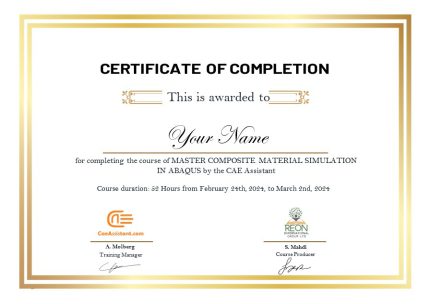
Ready to Join?
First Session for Free!
This course is perfect for:
➤ CAE Engineers Who Are Advanced Abaqus Users: You’re already proficient in Abaqus and eager to extend your capabilities. Gain a competitive edge and propel your career forward with subroutine mastery.
➤ Professors of Mechanical Engineering and Undergraduate Students: Elevate your research capabilities and explore cutting-edge simulation with various subroutines. Enhance your research expertise by mastering subroutines.
➤ Busy engineers who value their time: Optimize your learning, save time, and gain a thorough understanding of subroutines in a structured and focused manner. You’ll get everything you need in a single, well-organized package.
Take your Abaqus skills to the next level with our subroutine course. Enroll now and get the first session free!
Course Map
Take a Sneak Peek Before You Enroll!
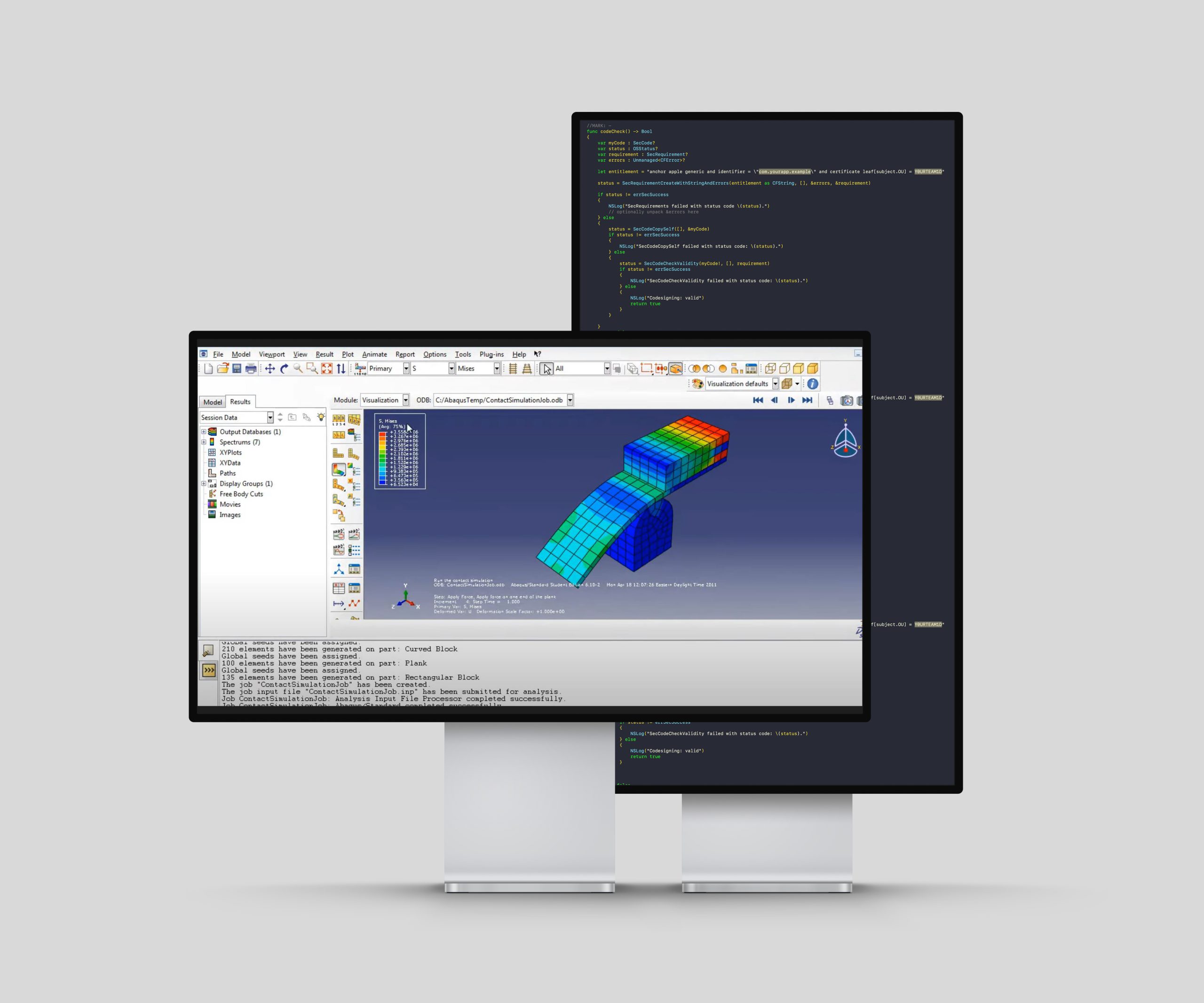
Why Choose CAE Assistant for Subroutine Course
Frequency Asked Questions
This course is designed for experienced Abaqus users who have a good understanding of the basic concepts of finite element analysis (FEA) and are familiar with the Abaqus interface. But you don’t need any Fortran background for this course
The course will cover a wide range of subroutines, including:
- Material Subroutines: UMAT, VUMAT, USDFLD, UHYPER, UHARD, VUHARD, UMATHT, UGEN
- Load Subroutines: VDLOAD, DLOAD, DFLUX, UAMP, VUAMP
- Boundary Condition Subroutines: DISP, VDISP
- Mesh Subroutines: UMESHMOTION
- Other Subroutines: VUEL, VFRICTION, VFRIC, UVARM, VUVARM, UEXPAN, VUEXPAN
The course includes over 55 practical exercises, each derived from real-world engineering problems addressed in master’s and doctoral theses. These exercises are designed to be challenging and will help you apply your knowledge of subroutines to solve complex engineering scenarios.
We understand that learning subroutines can be challenging. That’s why we offer personalized guidance and troubleshooting from experienced instructors throughout the course. You can ask questions, get clarification on concepts, and receive help with exercises.
Upon successful completion of the course, you will receive a valuable certificate that demonstrates your expertise in Abaqus subroutines. You will also gain access to a comprehensive course resource library for future reference.




